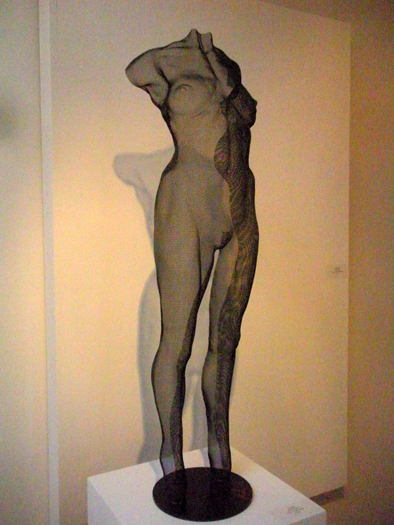
If one were to go by recent history, it would seem that exhibitions featuring the nude figure are the current style du jour among many of the galleries, both here on the East End as well as in other art world venues.
This trend continues in the current exhibitions at two Sag Harbor spaces, the Delaney-Cooke Gallery, which is featuring an exhibit of nude photographs, and the Hooke Sculpture Gallery, which, while currently presenting a group show, nevertheless includes a series of stylized nude figures, thereby allowing me to tie together two otherwise completely unrelated exhibitions.
At Delaney-Cooke Gallery, the “Nude or Nearly” exhibition featuring works by six photographers reinforces Kenneth Clarke’s observation that “the nude does not simply represent the body, but relates it, by analogy, to all structures that have become part of our imaginative experience.”
Or, as Michelangelo more simply stated, “He who does not master the nude, cannot understand the principles of architecture.”
This sense of structure is particularly apparent in Jonathan Morse’s “Spoons” and “Legs” (both archival digital print), each of which uses a powerful juxtaposition of skin tone to create compositional arrangements that are also rhythmic and, at moments, entertainingly abstract.
This sense of rhythm is also apparent in Jerry Cooke’s photographs, whether they are of Olympic athletes or 1950s era strippers. In both cases, the spontaneity of motion and its attendant harmonic overtones serve to orchestrate the compositions themselves.
This kind of orchestration is notably effective in “Cathy Rigby Jumping,” in which the central figure’s slight blur of motion conjures the energy of flight itself, while in “Micki King Diving Through the Air” this same sensation is created by the manner Ms. King seems frozen in mid-air, her body arching through the compositional plane and extending beyond the limits of the frame itself.
While Linda Alpern uses a similar compositional approach in one of the works from her “J-Series” (all silver fiber selenium toned prints), for the most part she uses the elements of the nude central image as actual components of an architectonic space. The manner in which these figures are posed creates really interesting narratives while at the same time using the figures as representing something more than just a naked person doing a handstand in the corner of the room.
Narrative is also a more immediate component in Jenny Gorman’s works, such as in “Portobello Hotel,” which uses both the nude figure in a bathroom brushing his teeth and the photographer herself as elements in what is a strikingly cinematic construct. This is emphasized by the eye contact the viewer has with the nude figure in the mirror as well as the reflection of the partially nude photographer, who herself seems merely a mirrored suggestion of reality.
In Anne Sager’s “Homage to Velasquez” (chromagenic print), on the other hand, the reclining nude in the center of the image is a mere component, offering a flesh-toned contrast to the colorful cacophony of patterns, shades, and shadows of the textiles on which she lies.
This technique of making the figure a juxtapositional element in the composition is also true of Christophe Von Hohenberg’s silver print, “Nude on the Rocks,” although here the essential contrasting components are the sensuous folds and shadows of the rocks on which the model lies curled, her own form echoing the natural formations around her.
The exhibition “Nude and Nearly” continues at the Delaney-Cook Gallery in Sag Harbor through June 29.
While there is one artist, David Begbie, at the Hook Sculpture Gallery who uses nude imagery, the more important overriding theme in the exhibition is figuration itself.
In Mr. Begbie’s work, though, the use of the human figure takes on interestingly abstract overtones in the mesh wiring construction, which gives the pieces a decidedly mysterious and apparition-like ambiance. At the same time, this measure of abstraction is balanced by the artist’s remarkable attentiveness to muscular forms within the figure, which serves to tie the works to more traditional figurative approaches.
Aspects of abstraction also influence Peter Eugene Bull’s inventively manipulated sculptures made from pieces of driftwood crafted into representations of images from literature, such as in “Crossing the Styx,” which is based on Dante’s “Inferno,” or “Travels on a Donkey,” which the artist extrapolated from Robert Louis Stevenson’s “Travels on a Donkey in the Cevennes.”
Also exhibiting at the Hooke Sculpture Gallery in Sag Harbor are Maurice Blik and Robert Hooke.
The exhibition continues through mid July.